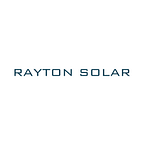How to Make High-Efficiency Gallium Arsenide Solar Cells Affordable
One of the highest quality semiconductor materials available today in solar panel production — gallium arsenide (GaAs) — appears to have met its perfect match. By coupling GaAs with a patented ion implantation process, Rayton Solar is a GaAs solar cell manufacturer aiming to develop cost-efficient solar cells that would open up new doors for specialty solar applications.
“Solar cells that use GaAs hold the record when it comes to the efficiency at which they convert sunlight into electricity,” said Bruce Clemens, a professor of materials science and engineering at Stanford University. GaAs is used today in a handful of applications primarily by NASA and the military for satellites, spacecraft, and UAVs. It holds many advantages over silicon — low-temperature coefficient, good low light performance, excellent efficiency, and flexibility. But because it is much more expensive than silicon (GaAs wafers are over 100 times more expensive than silicon wafers), economical use of GaAs is almost non-existent.
Rayton’s particle accelerator technology finally makes GaAs affordable enough for use. By using just a sliver of the expensive raw material, Rayton can reduce the cost substantially and bring solar power charging to various electronics affordably. Silicon solar cells take far too long to charge to warrant using them in electronic applications. The industry standard silicon cells have a ~17% module efficiency versus GaAs that can attain 27%+ module efficiency.
How Will Rayton Solar use GaAs in Solar Cell Production?
Rayton solar cells consist of a thin two-micron layer of gallium arsenide film exfoliated from an ingot using an ion-cutting technique. GaAs is the ideal material for single junction solar cells because its bandgap is almost optimal for solar energy conversion. A high-quality GaAs crystal can be mass produced in a similar method as a silicon crystal.
Thanks to its direct bandgap property, GaAs only needs minimal material to absorb light. Our approach only uses two-micron thick GaAs, which is only 1/100th of a regular wafer.
Below are the four major steps of thin GaAs solar cell fabrication using an ion implantation process:
- Proton implantation: A beam of protons is accelerated and directed at the GaAs ingot. The protons penetrate to a depth of two microns below the surface.
- Bonding: The implanted ingot is bonded to a less expensive carrier such as glass using wafer bonding techniques such as anodic bonding.
- Exfoliation: The bonded material is annealed in a furnace or on a hot plate; during the annealing, the implanted protons recombine into hydrogen platelets and cause stress inside the crystal. This stress creates micro-cracks below the surface which propagates and spreads along a plane parallel to the surface and then separates the top thin layer from the ingot. The remaining GaAs ingot is put back to the first step until all the material is completely exfoliated.
- Device fabrication: The exfoliated thin GaAs film on glass is fabricated to create solar cells using standard semiconductor processing including metallization, doping, and anti-reflective coating.
Where Will Gallium Arsenide Solar Cells Be Used?
Rayton Solar’s GaAs solar cells could be added to the rooftops of electric vehicles using the sun’s rays instead of plugging in for grid electricity. EVs have limited range due to battery capacity but by embedding our high-efficiency, lightweight solar cells into EVs, with one day’s charge an EV’s range can be extended by 35 miles. Given that the average US driver’s daily commute is 30 miles, this will allow EVs to run on pure clean energy, rather than plugging into the grid derived from ~60–70% fossil fuels in California. The solar cells could also be used to power everyday use of cell phones, headphones, drones, and many more electronic devices that would no longer need to charge with grid electricity, which is still mainly derived from fossil fuels.
Originally published at raytonsolar.com on April 18, 2018.
